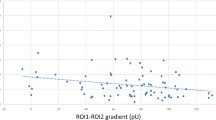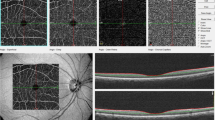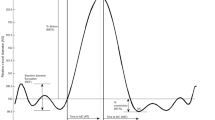Abstract
Cardiovascular disease is the main cause of mortality in chronic kidney disease (CKD). Endothelial dysfunction and capillary rarefaction are established cardiovascular risk factors. Nailfold video capillaroscopy provides a thorough assessment of capillary density and functional reserve. This study aimed to examine possible differences in structural and functional capillary density in CKD stages 2–4 with nailfold video capillaroscopy. Ninety-six CKD patients, divided into four equally sized groups according to CKD stage (2, 3a, 3b, 4), underwent nailfold video capillaroscopy, during which capillary density was measured at baseline, after 4-min arterial occlusion and after 2-min venous occlusion. Arterial stiffness and wave parameters were measured with applanation tonometry and common carotid intima-media thickness (ccIMT) with ultrasound. Baseline capillary density showed a progressive reduction with advancing CKD stages (stage 2: 32.6 ± 2.8, stage 3a: 31.2 ± 3.8, stage 3b: 32.5 ± 3.3, stage 4: 28.5 ± 3.1, p = 0.011). Similar reductions were observed during postocclusive hyperemia (39.4 ± 3.0, 37.6 ± 4.2, 38.4 ± 3.8, and 33.8 ± 3.3, respectively; p = 0.021) and after venous congestion (41.1 ± 3.1, 39.0 ± 4.4, 39.9 ± 3.5, and 35.2 ± 3.4; p = 0.032). Office PWV and ccIMT showed nonsignificant increasing trends with advancing CKD. In multivariate analysis, eGFR showed a positive association (per ml/min increase; β: 0.053, 95% CI: 0.004–0.101), whereas diabetes (β: −1.706, 95% CI: −3.176 to −0.236) and parathyroid hormone (PTH) (per pg/ml increase; β: −0.022, 95% CI: −0.036 to −0.008) had negative associations with postocclusive capillary density. Both structural and functional capillary density progressively decrease with advancing CKD stages. Apart from reduced eGFR, diabetes and increased PTH levels are independently associated with this reduction. This capillary rarefaction may largely contribute to the increased cardiovascular risk of CKD patients.
This is a preview of subscription content, access via your institution
Access options
Subscribe to this journal
Receive 12 print issues and online access
$259.00 per year
only $21.58 per issue
Buy this article
- Purchase on Springer Link
- Instant access to full article PDF
Prices may be subject to local taxes which are calculated during checkout


Similar content being viewed by others
References
Saran R, Li Y, Robinson B, Abbott KC, Agodoa LY, Ayanian J, et al. US Renal Data System 2015 annual data report: epidemiology of kidney disease in the United States. Am J Kidney Dis. 2016;67:S1–305.
Go AS, Chertow GM, Fan D, McCulloch CE, Hsu CY. Chronic kidney disease and the risks of death, cardiovascular events, and hospitalization. N Engl J Med. 2004;351:1296–305.
Georgianos PI, Sarafidis PA, Lasaridis AN. Arterial stiffness: a novel cardiovascular risk factor in kidney disease patients. Curr Vasc Pharmacol. 2015;13:229–38.
Townsend RR. Arterial stiffness in CKD: a review. Am J Kidney Dis. 2019;73:240–7.
Briet M, Boutouyrie P, Laurent S, London GM. Arterial stiffness and pulse pressure in CKD and ESRD. Kidney Int. 2012;82:388–400.
Schiffrin EL, Lipman ML, Mann JF. Chronic kidney disease: effects on the cardiovascular system. Circulation. 2007;116:85–97.
Zoccali C. Endothelial dysfunction and the kidney: emerging risk factors for renal insufficiency and cardiovascular outcomes in essential hypertension. J Am Soc Nephrol. 2006;17:S61–3.
Carrero JJ, Stenvinkel P. Inflammation in end-stage renal disease—what have we learned in 10 years? Semin Dial. 2010;23:498–509.
Xu Y, Arora RC, Hiebert BM, Lerner B, Szwajcer A, McDonald K, et al. Non-invasive endothelial function testing and the risk of adverse outcomes: a systematic review and meta-analysis. Eur Heart J Cardiovasc Imaging. 2014;15:736–46.
Serne EH, de Jongh RT, Eringa EC, IJ RG, Stehouwer CD. Microvascular dysfunction: a potential pathophysiological role in the metabolic syndrome. Hypertension. 2007;50:204–11.
Levy BI, Schiffrin EL, Mourad JJ, Agostini D, Vicaut E, Safar ME, et al. Impaired tissue perfusion: a pathology common to hypertension, obesity, and diabetes mellitus. Circulation. 2008;118:968–76.
Eringa EC, Serne EH, Meijer RI, Schalkwijk CG, Houben AJ, Stehouwer CD, et al. Endothelial dysfunction in (pre)diabetes: characteristics, causative mechanisms and pathogenic role in type 2 diabetes. Rev Endocr Metab Disord. 2013;14:39–48.
Feletou M, Vanhoutte PM. Endothelial dysfunction: a multifaceted disorder (The Wiggers Award Lecture). Am J Physiol Heart Circ Physiol. 2006;291:H985–1002.
Sarafidis PA, Loutradis C, Karpetas A, Tzanis G, Piperidou A, Koutroumpas G, et al. Ambulatory pulse wave velocity is a stronger predictor of cardiovascular events and all-cause mortality than office and ambulatory blood pressure in hemodialysis patients. Hypertension. 2017;70:148–57.
Hinderliter A, Padilla RL, Gillespie BW, Levin NW, Kotanko P, Kiser M, et al. Association of carotid intima-media thickness with cardiovascular risk factors and patient outcomes in advanced chronic kidney disease: the RRI-CKD study. Clin Nephrol. 2015;84:10–20.
Triantafyllou A, Anyfanti P, Pyrpasopoulou A, Triantafyllou G, Aslanidis S, Douma S. Capillary rarefaction as an index for the microvascular assessment of hypertensive patients. Curr Hypertens Rep. 2015;17:33.
Antonios TF, Singer DR, Markandu ND, Mortimer PS, MacGregor GA. Structural skin capillary rarefaction in essential hypertension. Hypertension. 1999;33:998–1001.
Serne EH, Gans RO, ter Maaten JC, Tangelder GJ, Donker AJ, Stehouwer CD. Impaired skin capillary recruitment in essential hypertension is caused by both functional and structural capillary rarefaction. Hypertension. 2001;38:238–42.
Afsar B, Afsar RE, Dagel T, Kaya E, Erus S, Ortiz A, et al. Capillary rarefaction from the kidney point of view. Clin Kidney J. 2018;11:295–301.
Chade AR. Renal vascular structure and rarefaction. Compr Physiol. 2013;3:817–31.
Thang OH, Serne EH, Grooteman MP, Smulders YM, ter Wee PM, Tangelder GJ, et al. Capillary rarefaction in advanced chronic kidney disease is associated with high phosphorus and bicarbonate levels. Nephrol Dial Transplant. 2011;26:3529–36.
Edwards-Richards A, DeFreitas M, Katsoufis CP, Seeherunvong W, Sasaki N, Freundlich M, et al. Capillary rarefaction: an early marker of microvascular disease in young hemodialysis patients. Clin Kidney J. 2014;7:569–74.
KDIGO CKD Work Group. KDIGO 2012 clinical practice guideline for the evaluation and management of chronic kidney disease. Kidney Int Suppl. 2013;3:1–150.
Williams B, Mancia G, Spiering W, Agabiti Rosei E, Azizi M, Burnier M, et al. 2018 ESC/ESH Guidelines for the management of arterial hypertension: the Task Force for the management of arterial hypertension of the European Society of Cardiology and the European Society of Hypertension. J Hypertens. 2018;36:1953–2041.
van Sloten TT, Czernichow S, Houben AJ, Protogerou AD, Henry RM, Muris DM, et al. Association between arterial stiffness and skin microvascular function: the SUVIMAX2 study and the maastricht study. Am J Hypertens. 2015;28:868–76.
Laurent S, Cockcroft J, Van Bortel L, Boutouyrie P, Giannattasio C, Hayoz D, et al. European Network for Non-invasive Investigation of Large Arteries. Expert consensus document on arterial stiffness: methodological issues and clinical applications. Eur Heart J. 2006;27:2588–605.
Sarafidis PA, Georgianos PI, Karpetas A, Bikos A, Korelidou L, Tersi M, et al. Evaluation of a novel brachial cuff-based oscillometric method for estimating central systolic pressure in hemodialysis patients. Am J Nephrol. 2014;40:242–50.
Stein JH, Korcarz CE, Hurst RT, Lonn E, Kendall CB, Mohler ER, et al. American Society of Echocardiography Carotid Intima-Media Thickness Task Force. Use of carotid ultrasound to identify subclinical vascular disease and evaluate cardiovascular disease risk: a consensus statement from the American Society of Echocardiography Carotid Intima-Media Thickness Task Force. Endorsed by the Society for Vascular Medicine. J Am Soc Echocardiogr. 2008;21:93–111.
Sarafidis PA, Bakris GL. Review: insulin and endothelin: an interplay contributing to hypertension development? J Clin Endocrinol Metab. 2007;92:379–85.
Flammer AJ, Anderson T, Celermajer DS, Creager MA, Deanfield J, Ganz P, et al. The assessment of endothelial function: from research into clinical practice. Circulation. 2012;126:753–67.
Choi HR, Lee SW, Jeon DH, Hur NW, Youm Y, Kim HC. Association between estimated glomerular filtration rate (eGFR) and asymmetric dimethylarginine (ADMA) concentrations among the elderly in a rural community: a cross-sectional study. BMC Geriatr. 2019;19:370.
Antonios TF, Singer DR, Markandu ND, Mortimer PS, MacGregor GA. Rarefaction of skin capillaries in borderline essential hypertension suggests an early structural abnormality. Hypertension.1999;34:655–8.
Lundwall K, Jorneskog G, Jacobson SH, Spaak J. Paricalcitol, microvascular and endothelial function in non-diabetic chronic kidney disease: a randomized trial. Am J Nephrol. 2015;42:265–73.
Kobayashi S, Oka M, Maesato K, Ikee R, Mano T, Hidekazu M, et al. Coronary artery calcification, ADMA, and insulin resistance in CKD patients. Clin J Am Soc Nephrol. 2008;3:1289–95.
Fujimi-Hayashida A, Ueda S, Yamagishi S, Kaida Y, Ando R, Nakayama Y, et al. Association of asymmetric dimethylarginine with severity of kidney injury and decline in kidney function in IgA nephropathy. Am J Nephrol. 2011;33:1–6.
Raptis V, Georgianos PI, Sarafidis PA, Sioulis A, Makedou K, Makedou A, et al. Elevated asymmetric dimethylarginine is associated with oxidant stress aggravation in patients with early stage autosomal dominant polycystic kidney disease. Kidney Blood Press Res. 2013;38:72–82.
Ginsberg C, Houben A, Malhotra R, Berendschot T, Dagnelie PC, Kooman JP, et al. Serum phosphate and microvascular function in a population-based cohort. Clin J Am Soc Nephrol. 2019; 14:1626–33.
London GM, Pannier B. Arterial functions: how to interpret the complex physiology. Nephrol Dial Transplant. 2010;25:3815–23.
Samdani AF, Dawson TM, Dawson VL. Nitric oxide synthase in models of focal ischemia. Stroke. 1997;28:1283–8.
Author information
Authors and Affiliations
Corresponding author
Ethics declarations
Conflict of interest
The authors declare that they have no conflict of interest.
Additional information
Publisher’s note Springer Nature remains neutral with regard to jurisdictional claims in published maps and institutional affiliations.
Rights and permissions
About this article
Cite this article
Schoina, M., Loutradis, C., Memmos, E. et al. Microcirculatory function deteriorates with advancing stages of chronic kidney disease independently of arterial stiffness and atherosclerosis. Hypertens Res 44, 179–187 (2021). https://doi.org/10.1038/s41440-020-0525-y
Received:
Revised:
Accepted:
Published:
Issue Date:
DOI: https://doi.org/10.1038/s41440-020-0525-y
Keywords
This article is cited by
-
Capillary rarefaction: a missing link in renal and cardiovascular disease?
Angiogenesis (2024)
-
Urinary free cortisol excretion is associated with lumbar bone density in patients with adrenal Cushing’s syndrome
Hypertension Research (2022)
-
Nailfold videocapillaroscopic changes in patients with pulmonary arterial hypertension associated with connective tissue diseases
Rheumatology International (2021)
-
Vascular endothelial injury assessed with functional techniques in systemic sclerosis patients with pulmonary arterial hypertension versus systemic sclerosis patients without pulmonary arterial hypertension: a systematic review and meta-analysis
Rheumatology International (2021)



